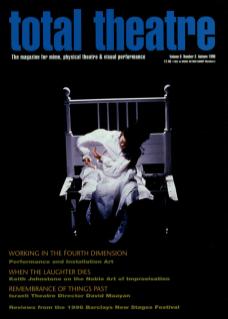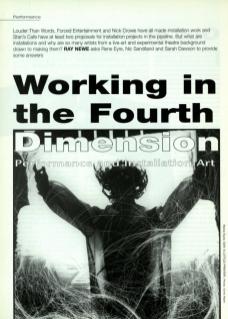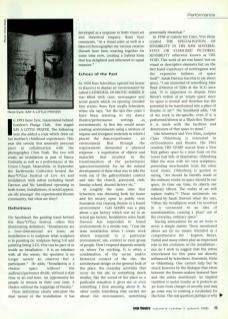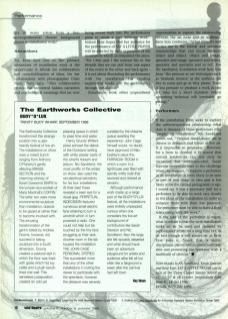In 1993 Rene Eyre, mastermind behind London's Plunge Club, first staged Say a Little Prayer. The following year she added a coda which drew on her mother's childhood experiences. This year she revisits this intensely personal piece in collaboration with the photographer Chris Nash. The two will create an installation as part of Dance Umbrella as well as a performance at the Union Chapel. Meanwhile, in September the Earthworks Collective hosted the Buoy *O* Lux Festival of Live Art and Installation with artists including Sarah Dawson and Nic Sandiland operating in both forms. Installations, it would appear, are rife amongst the experimental theatre community, but what are they?
Definitions
Nic Sandiland, the guiding hand behind the Buoy *O* Lux festival, offers this illuminating definition, ‘Installations are a four-dimensional art form; an installation is to sculpture what sculpture is to painting (i.e., sculpture being 3D and painting being 2D). One can be part of or inside an installation – it is an interface with all the senses, the spectator is no longer merely an observer but a participant.’ He adds, ‘Installation is a theatre space without the audience/performer divide, without a start time or an end time. An opportunity for people to witness in their own time. A theatre without the trappings of theatre.’
These definitions clearly articulate the dual nature of the installation. It has developed as a response to both visual art and theatrical enquiry. Rene Eyre comments, ‘As a visual artist as well as a dancer/choreographer my various creative threads have been weaving together for some time now, creating a hybrid form that has delighted and infuriated in equal measure.’
Echoes of the Past
In 1924 Kurt Schwitters opened his house in Hanover to display an 'environment' he called Cathedral of Erotic Misery. It was filled with cans, newspapers and secret panels which on opening revealed tiny scenes. Rene Eyre recalls Schwitters when she says, ‘for the last five years I have been referring to my dance theatre/performance settings as environments. At first this would mean creating environments using a mixture of organic and inorganic materials in which I placed the dancer/performer – an environment that through the requirements demanded a physical response; a negotiation of objects and materials that resulted in the transformation of the performance space/environment. For me the natural development of these ideas was to take the work out of the gallery/theatre context and into the church, graveyard, club, Sunday school, disused factory etc.’
At roughly the same time that Schwitters was throwing both his home and his misery open to public view, Eisenstein was creating theatre in a found environment. Gas Masks was a play about a gas factory which was set in an actual gas factory. Installation artist Sarah Dawson has responded to found environments in a similar way. ‘I use the term installation when I create work which responds to a particular environment, site, context or even group of people. How I respond depends entirely on where I'm working. It is often a combination of the social and/or historical context of the site, the architectural design or the general look of the place, the everyday activities that occur on the site or something much smaller, like the sound of the place or a particular sensation it gives me or even something I find amusing about it. In other words something that excites me about the environment, something potentially theatrical.’
In 1958 at Galerie Iris Clert, Yves Klein created The Specialisation of Sensibility in the Raw Material State or Stabilised Pictorial Sensibility otherwise known as The Void. This work of art was based 'not on visual or descriptive elements but on the first hand experience of nothingness and the expansive fullness of space itself'! Sarah Dawson has this to say about space, ‘I am reminded of something Alan Read (Director of Talks at the ICA) once said, “It is important to dispute Peter Brook's notion of an empty space since no space is neutral and therefore has the potential to be transformed into a place of theatre or art.'" Nic Sandiland adds, ‘All of my work is site-specific, even if it is performed/shown in a “Black-Box Theatre” it is made with the facilities and dimensions of that space in mind.’
Like Schwitters and Yves Klein, sculptor Claes Oldenburg is interested in environments and theatre. His 1961 creation The Store moved from a New York gallery space to a store front on the Lower East Side of Manhattan. Oldenburg filled the store with his own sculptures, presenting merchandise from the other local stores. Oldenburg is quoted as saying, ‘Art should be literally made of the ordinary world; its space should be our space, its time our time, its objects our ordinary effects. The reality of art will replace reality.’ These sentiments are echoed by Sarah Dawson when she says, ‘Often the installation work I'm involved in is connected to an idea of transformation, creating a “place” out of the everyday, ordinary space.’
Tracing antecedents for an artform is never a simple matter. Those mentioned above are by no means intended as a comprehensive list – Kaprow, Beuys, Nuttal and many others play an important role in the evolution of the installation – nor do I wish to suggest that the artists interviewed for this piece are directly influenced by Schwitters, Eisenstein, Klein or Oldenburg. One cannot help but be struck however by the dialogue that exists between the theatre-makers featured here and the artists mentioned. An implied tradition is useful insofar as it protects an artform from charges of novelty and may go some way to creating a vocabulary for the form. The real question perhaps is why are so many artists from a live art / experimental theatre background drawn to installation work?
Attractions
For Rene Eyre one of the primary attractions of installation work is the opportunity it affords for collaboration and cross-fertilisation of ideas. On her collaboration with photographer Chris Nash, Rene says, ‘This collaborative process has uncovered hidden narratives and psychological meanings that are now being woven back into the performance piece to create a very different work.’ Indeed Rene hopes that her audience for the performance of Say a Little Prayer will be affected by their experience of the Installation which accompanies the piece. ‘For Chris and I the interest lies in the threads that we can pull from one aspect of the event to the other and back again – it is not about illustrating the performance with the installation but creating experiential hooks into the performance through installation.’
Installation work offers unparalleled opportunities to explore the relationship between the artform and its audience. Rene Eyre continues, ‘What interests and excites me is the formal and informal relationships that can occur between object and object, object and image, spectator and image, spectator and object, spectator and spectator and so on.’ For Nic Sandiland, installation work frees him from the pressure to use techniques such as 'dramatic tension as the audience are free to come and go as they please. There is less pressure to produce a work at one set time for a short duration (when something technical will inevitably go wrong).’
Performers
If the installation form seeks to explore the artform/spectator relationship what does it demand of those performers who 'people' an installation? Nic Sandiland points out, ‘Peopled installations are as diverse in demands and nature as live art. It is impossible to generalise.’ However, for a form to develop it is crucial that central tendencies can not only be identified but communicated. Sarah Dawson tentatively rises to the challenge when she suggests, ‘I suppose a performer in an installation is more likely to be seen as part of one image or idea and is less likely to be the central protagonist or ego. I would say it was a necessary skill for a performer to be able to work very closely to the ideas of the installation in order to enhance them with their live presence. The performer must be able to have a fluid relationship with the work.’
If the role of the performer is vague, what is certain is that the term installation looks set to be used and misused by performance artists for a long time yet. At its best though it will always be, as Rene Eyre puts it, ‘work that is multidisciplined, placed within unconventional sites and presenting the spectator with a multitude of choices’.
The Earthworks Collective, Buoy *O* Lux, Trinity Buoy Wharf, September 1996
The Earthworks Collective transformed this strange location into a user friendly festival of live art. The installations on show were a mixed bunch ranging from Anthony O'Flaherty's gently affecting Brass Section and the charming whimsy of Sarah Dawson's Ships to the lumpen eco-protest of Maria Marshall's Coffin. The latter two were more environmental sculpture than installation; objects to be gazed at rather than to become involved with. The amusing transformation of the gents toilets by Andrew Downs, however, did succeed in taking sculpture into a fourth dimension. Downs created a pastoral idyll in which the floor was lined with grass which hid toy cattle and a plush bench lined one wall. This senseless juxtaposition created an odd yet pleasing space in which to pass time and water.
Henry Grundy White's piece echoed the debris of the Dockland setting with white plaster casts of the wharf's flotsam and jetsum. Nic Sandiland, the most prolific of the artists on show, also used the old electrical laboratory for his four installations. At their best these revealed a keen eye for a visual gag. Perpetual Indecision featured numerous small electric fans straining to turn a windmill which in turn powered a radio. One could not help but be touched by the tiny fans struggling at their task. Another room in the lab housed the installation The John Cage Personal Stereo. This succeeded more than any of the other installations in inviting the viewer to participate with the spectacle, however the pleasure was severely curtailed by the irksome queue awaiting the experience. John Cage himself would, no doubt, have approved of Max Eastley's piece Farraday Room in which a room in a lighthouse was filled with spindly white rods that revolved and clicked at random.
Although performance work made up a large part of the Buoy *O* Lux festival, all the installations were entirely unpeopled, curious when one considers the live art background of contributors like Sarah Dawson and Nic Sandiland. Also the large site felt spookily deserted and what should have been an adventure playground for artists and audience alike felt all too often like a fairground a week after the carnival had left town.



